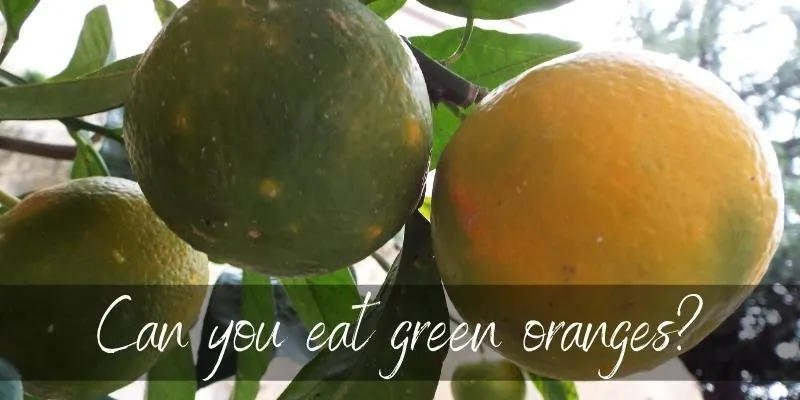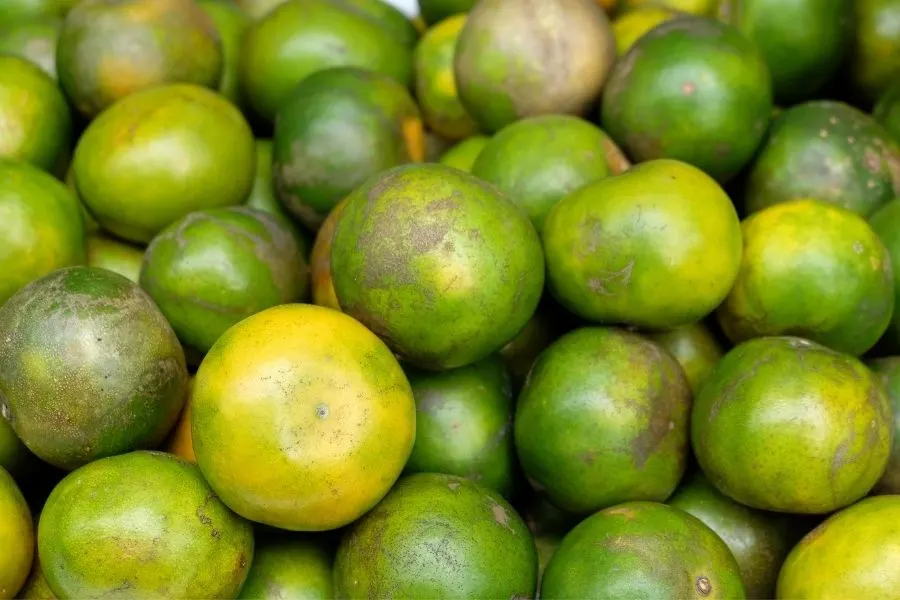You don’t see too often green or unripe oranges in the market or stores, so when you see an orange that is not completely orange, it is perfectly fine to ask yourself if it’s safe to eat?
I saw just a few times oranges that had some green spots in the store, but I never saw a green orange like a lime since I live in a country where oranges don’t grow naturally, which means that all the oranges I saw were imported.
It’s important if the oranges were imported or not in regard to their color as a good indicator of their ripeness.
In this article, we will talk about the difference between unripe and green oranges, if it’s safe to eat them both, and what you can do with them.

Can you eat green oranges?
Green oranges are safe to eat, the green color is due to the chlorophyll that is produced to protect the peel from sunburn. However, while they are safe to eat, that doesn’t mean that they will have a good taste and texture.
Completely green oranges are most probably unripe, especially if they are a darker green, while an orange with some bright green spots can be fully ripe and delicious.
If the oranges are imported to your country, there are little chances that you will ever see a dark green color orange since the oranges don’t ripen any more after they’ve been picked. That means that all the farmers will wait until they are completely ripe before picking them.
If you live in a place where oranges grow naturally, you will have bigger chances to see oranges with a slightly green color that are perfectly ripe.
Read Also: When Is Persimmon Ripe?
Can you eat unripe orange?
Yes, you can eat unripe oranges, but they will have a sour, tart taste. It is a bit hard to determine if the oranges are unripe just by looking at them since the color is not the best indicator of their ripeness.
Imported oranges can be dyed to have a nicer orange color. Also, exposing the orange to fruits that emit ethylene, like bananas, apples, pears, mangoes, etc., will give them a better orange color.
So if you want to make sure that the orange is ripe, you have to smell it. If it has a slightly sweet smell, it means that the orange is most probably ripe. Another way to know if the orange is ripe is to check its weight, when you hold a ripe orange, it should feel heavy for its size, and also, the peel should be quite firm.

Is it safe to eat orange peel?
Orange peel is safe to eat in small quantities. Orange peals actually have more fiber than the fruit itself, but they can cause stomach problems when consumed in large quantities.
Suppose you plan to eat the orange peel. In that case, it is highly recommended to wash it first since it can contain a lot of pesticides and other chemicals used to preserve the fruit for longer periods. Also, you don’t know in what conditions the fruit was stored, so it is better to wash it thoroughly before eating it.
While the orange peel is not commonly eaten as is, orange zest has a lot of uses. I will let you know a few of them:
-Sauce. You can use the orange zest to make a great orange sauce which can work great with a delicious duck breast or some beef stacks, but it also can be used in many other recipes.
-Baking. It can give a great sweet citrus flavor to any baked dessert you want to go for. While it adds a great flavor, it doesn’t change the balance of ingredients in your recipe since you need a small amount of zest to get a good flavor out of it.
-Salad. You can add orange zest to any type of salad you like, but as well as the sauce will work great with a roasted duck breast salad or a beef salad.
How to choose a good orange?
In order to have a great delicious orange, you should know what to look for when you buy an orange. For this reason, I will give you a few things to check every time you buy oranges:
-Texture. The texture is the most important thing you can when buying an orange. A ripe orange should have a firm texture without any softer spots. If it has softer spots, it is a sign that it is overripe or is going bad.
-Weight. A good orange should feel heavy for its size.
-Appearance. While the color is not the best indication of the ripeness of an orange, it will be safer to go for the ones that don’t have any discontinuation in their color or weird spots. Also, make sure you check the oranges for the mold spots. It often happens that in a pile of oranges, a few of them already have mold on them.
-Smell. A ripe orange should have a sweet, citrusy smell, if the orange doesn’t have any smell, signify that it is not fully ripe.
If somehow you end up with an orange that is not fully ripe, you can use still use it in your favorite drinks like an orange lemonade or an orange juice with a bit of added sugar to cover its sour taste.
Read Also: Best Orange Marmalade Substitute
Conclusion
The conclusion is that green oranges are not necessarily unripe oranges, and both of them are safe to eat anyway. However, if you want a sweet, delicious orange, you should not eat one that is not completely ripe.
Make sure to check all the signs that we talked about above before buying a good orange, and don’t make your decision only based on the color of the fruit.
I hope this article clears the confusion between green and unripe orange and helps you choose the best fruits.

